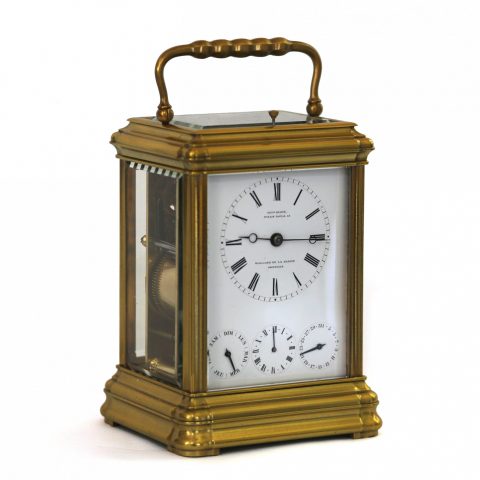Calendar alarm Striking Carriage Clock by Charles Oudin

Charles Oudin was from a French dynasty of clockmakers which began with his grandfather Jean-Baptiste Oudin in the mid 18th century. His grandson Jean Charles Oudin, known as Charles Oudin (1768-1840), married Antoinette Leroy, who also came from the Leroy watchmaking dynasty. Charles worked closely with “the father of modern horology”, renowned clockmaker Abraham-Louis Breguet (1747-1823). Such was Breguet’s respect for Charles, that he was awarded the great privelege of gaining his master’s authority to sign his work “Charles Oudin, élève de Breguet”.
This fine gorge-cased repeating carriage clock with double calendar-work and alarm functions is signed on the dial and again (engraved) on the sides of the plates. Dating from c.1860, the clock remains in excellent condition. The gilt lacquered case has barely any dents or marks.
The perfect white enamel dial is signed,
CHLES OUDIN, PALAIS ROYAL 52
HORLOGER DE LA MARINE IMPERIALE.[1]
The time dial has an outer minte track and finely fretted Breguet-style hands. below this dial are three subsidiary dials; left and right for day and date, and the alarm dial to the centre.
The eight-day movement strikes the hours and the passing of the half hour on a bell. Depressing the button on the top of the case will repeat the last hour struck. The movement retains its original large silvered platform escapement. Both plates are engraved on the side with the two addresses,
PALAIS ROYAL 52,
RUE MONTPENSIER No. 30
The address at Rue Montpensier, no. 30 was one occupied by watchmaker Amédée Charpentier, who acquired the Charles Oudin firm in 1857. During his ownership, the firm became internationally known, with shops or representatives in London and New York.
The clock is stamped on back plate, front-plate and the case base with serial number 998.
The movement is to be overhauled and the clock is sold with a three-year guarantee.
- Height (handle up) : 17 cms (6 1/2 inches)
- Width: 10.5 cms (4 1/4 inches)
- Depth: 9 cms (3 3/4 inches)
[1] The French Navy was known as la Marine Imperiale during the 18-year Imperial Bonapartist regime of Napoleon III from 14 January 1852 to 4 September 1870.